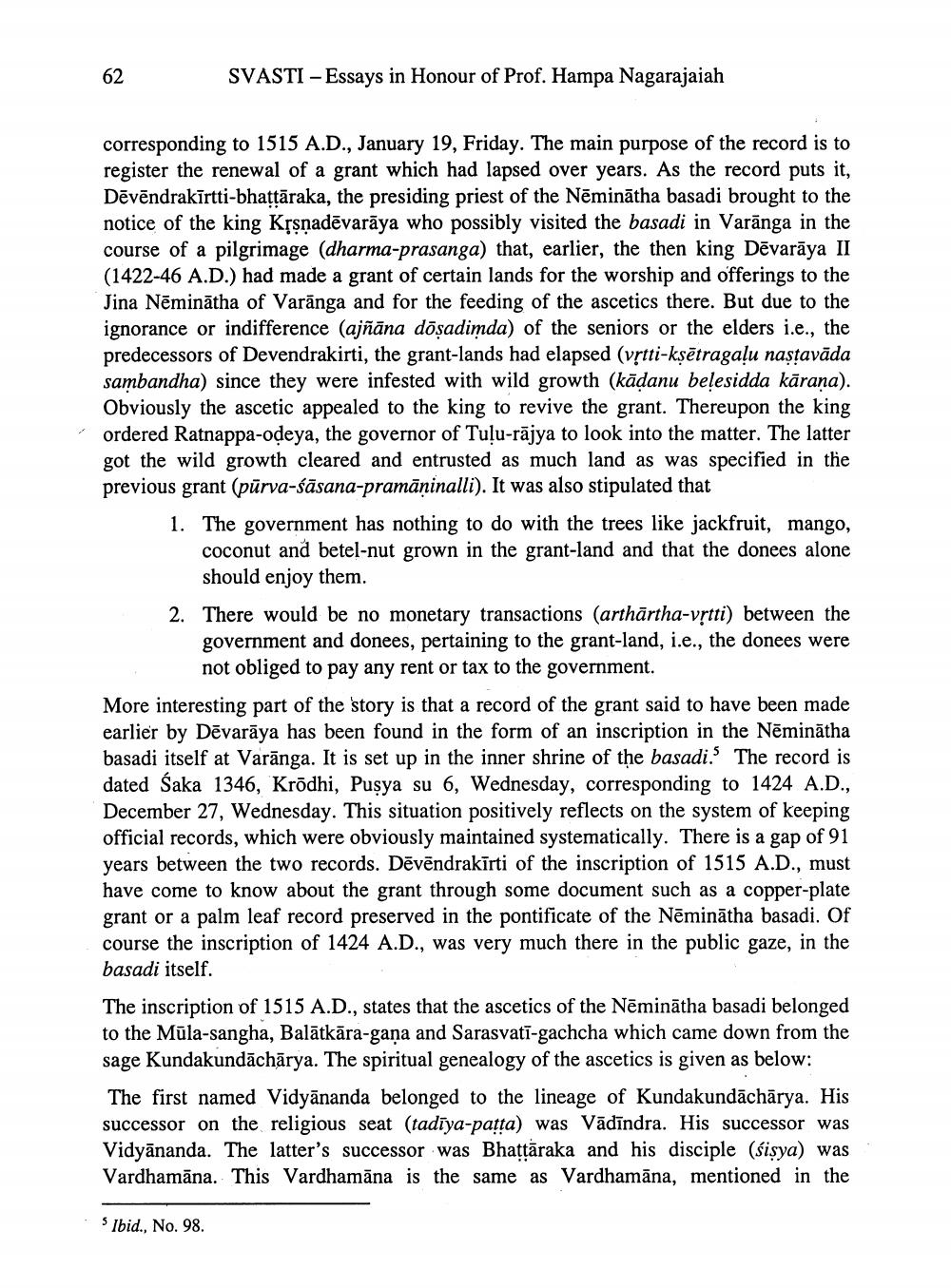________________
SVASTI - Essays in Honour of Prof. Hampa Nagarajaiah
corresponding to 1515 A.D., January 19, Friday. The main purpose of the record is to register the renewal of a grant which had lapsed over years. As the record puts it, Dēvēndrakīrtti-bhattāraka, the presiding priest of the Nēminātha basadi brought to the notice of the king Krsnadēvarāya who possibly visited the basadi in Varānga in the course of a pilgrimage (dharma-prasanga) that, earlier, the then king Dēvarāya II (1422-46 A.D.) had made a grant of certain lands for the worship and offerings to the Jina Nēminātha of Varānga and for the feeding of the ascetics there. But due to the ignorance or indifference (ajñāna dosadimda) of the seniors or the elders i.e., the predecessors of Devendrakirti, the grant-lands had elapsed (vrtti-ksētragalu nastavāda sambandha) since they were infested with wild growth (kādanu belesidda kārana). Obviously the ascetic appealed to the king to revive the grant. Thereupon the king ordered Ratnappa-odeya, the governor of Tuļu-rājya to look into the matter. The latter got the wild growth cleared and entrusted as much land as was specified in the previous grant (pūrva-śāsana-pramāṇinalli). It was also stipulated that
1. The government has nothing to do with the trees like jackfruit, mango,
coconut and betel-nut grown in the grant-land and that the donees alone
should enjoy them. 2. There would be no monetary transactions (arthārtha-vrtti) between the
government and donees, pertaining to the grant-land, i.e., the donees were
not obliged to pay any rent or tax to the government. More interesting part of the story is that a record of the grant said to have been made earlier by Dēvarāya has been found in the form of an inscription in the Nēminātha basadi itself at Varānga. It is set up in the inner shrine of the basadi. The record is dated Śaka 1346, Krõdhi, Pusya su 6, Wednesday, corresponding to 1424 A.D., December 27, Wednesday. This situation positively reflects on the system of keeping official records, which were obviously maintained systematically. There is a gap of 91 years between the two records. Dēvēndrakīrti of the inscription of 1515 A.D., must have come to know about the grant through some document such as a copper-plate grant or a palm leaf record preserved in the pontificate of the Nēminātha basadi. Of course the inscription of 1424 A.D., was very much there in the public gaze, in the basadi itself. The inscription of 1515 A.D., states that the ascetics of the Nēminātha basadi belonged to the Mūla-sangha, Balātkāra-gana and Sarasvatī-gachcha which came down from the sage Kundakundāchārya. The spiritual genealogy of the ascetics is given as below:
The first named Vidyānanda belonged to the lineage of Kundakundāchārya. His successor on the religious seat (tadīya-patta) was Vādīndra. His successor was Vidyānanda. The latter's successor was Bhattāraka and his disciple (śisya) was Vardhamāna. This Vardhamāna is the same as Vardhamāna, mentioned in the
Ibid., No. 98.




